External links
Coordinates: 53°07′16″N1°33′46″W / 53.1212°N 1.5627°W
The Life in a Lens Museum of Photography and Old Times was a museum in Matlock Bath, Derbyshire, England. Opened in 2001, the museum was dedicated to presenting the history of photography from 1839 to around the beginning of the digital age (2001) until its closure between 2017 and 2018.
The museum was housed in five themed rooms in a renovated Victorian building, dating from 1861, on North Parade. There were over five hundred cameras on display and many more items, including mannequins dressed in period clothes, many authentic Victorian or Edwardian.
Coordinates: 53°07′16″N1°33′46″W / 53.1212°N 1.5627°W
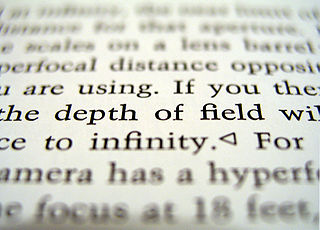
The depth of field (DOF) is the distance between the nearest and the furthest objects that are in acceptably sharp focus in an image captured with a camera.
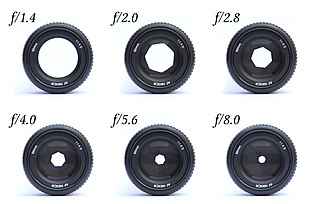
In optics, an aperture is a hole or an opening through which light travels. More specifically, the aperture and focal length of an optical system determine the cone angle of a bundle of rays that come to a focus in the image plane.
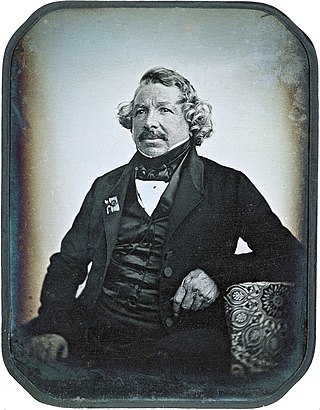
Daguerreotype was the first publicly available photographic process; it was widely used during the 1840s and 1850s. "Daguerreotype" also refers to an image created through this process.

Dorothea Lange was an American documentary photographer and photojournalist, best known for her Depression-era work for the Farm Security Administration (FSA). Lange's photographs influenced the development of documentary photography and humanized the consequences of the Great Depression.
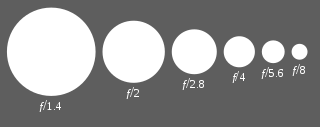
In optics, the f-number of an optical system such as a camera lens is the ratio of the system's focal length to the diameter of the entrance pupil. It is also known as the focal ratio, f-ratio, or f-stop, and is very important in photography. It is a dimensionless number that is a quantitative measure of lens speed; increasing the f-number is referred to as stopping down. The f-number is commonly indicated using a lower-case hooked f with the format f/N, where N is the f-number.

Louis Aimé Augustin Le Prince was a French artist and the inventor of an early motion-picture camera, possibly the first person to shoot a moving picture sequence using a single lens camera and a strip of (paper) film. He has been credited as the "Father of Cinematography", but his work did not influence the commercial development of cinema—owing at least in part to the great secrecy surrounding it.

Elizabeth Alice Austen was an American photographer working in Staten Island.

Macro photography is extreme close-up photography, usually of very small subjects and living organisms like insects, in which the size of the subject in the photograph is greater than life size . By the original definition, a macro photograph is one in which the size of the subject on the negative or image sensor is life size or greater. In some senses, however, it refers to a finished photograph of a subject that is greater than life size.

Street photography is photography conducted for art or enquiry that features unmediated chance encounters and random incidents within public places. Although there is a difference between street and candid photography, it is usually subtle with most street photography being candid in nature and some candid photography being classifiable as street photography. Street photography does not necessitate the presence of a street or even the urban environment. Though people usually feature directly, street photography might be absent of people and can be of an object or environment where the image projects a decidedly human character in facsimile or aesthetic.

Henry Peach Robinson was an English pictorialist photographer best known for his pioneering combination printing - joining multiple negatives or prints to form a single image; an early example of photomontage. He joined vigorously in contemporary debates in the photographic press and associations about the legitimacy of 'art photography' and in particular the combining of separate images into one.

The Nikon FM2 is an advanced semi-professional, interchangeable lens, 35 mm film, single-lens reflex (SLR) camera. It was manufactured by Nippon Kogaku K. K. in Japan from 1982 to 2001. The original camera was released with some incremental improvements in 1984, and this later version is commonly referred to as the FM2n, although both versions are labelled as the FM2 on the front of the camera body.
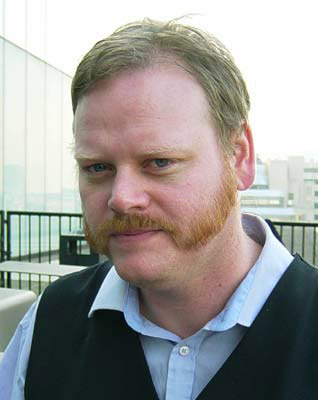
Wolf Howard is an English artist, poet and filmmaker living in Rochester, Kent and was a founder member of the Stuckists art group. He is also a drummer who has played in garage and punk bands, currently as a member of The Musicians of the British Empire (MBE's) with Billy Childish.
Depth of focus is a lens optics concept that measures the tolerance of placement of the image plane in relation to the lens. In a camera, depth of focus indicates the tolerance of the film's displacement within the camera and is therefore sometimes referred to as "lens-to-film tolerance".
Table Bluff Lighthouse is a lighthouse in California, United States, which was located on Table Bluff just south of Humboldt Bay. Built to guide vessels away from the notoriously dangerous and rough coastline and to let them know proximity of the nearby bay and entrance, the lighthouse was one of the first to be automated. The lighthouse tower portion is now located at the Woodley Island Marina within the City of Eureka.

The Photo-Secession was an early 20th century movement that promoted photography as a fine art in general and photographic pictorialism in particular.

In digital photography, the image sensor format is the shape and size of the image sensor.
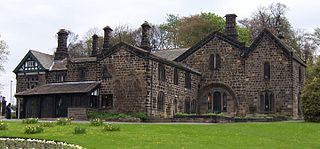
Abbey House Museum in Kirkstall, Leeds, West Yorkshire, England is housed in the gatehouse of the ruined 12th-century Kirkstall Abbey, and is a Grade II* listed building. The house is 3 miles (4.8 km) north west of Leeds city centre on the A65 road. It is part of the Leeds Museums & Galleries group.

The Canon EOS D2000 is a 2-megapixel digital single-lens reflex camera developed by Kodak on a Canon EOS-1N body. It was released in March 1998. It features a CCD sensor and can shoot at 3.5 frames per second. Many enthusiasts regard the D2000 as Canon's first truly usable Digital SLR. It was released in tandem with the Canon EOS D6000, a 6-megapixel model.

William Jay was a photographer, writer on and advocate of photography, curator, magazine and picture editor, lecturer, public speaker and mentor. He was the first editor of "the immensely influential magazine" Creative Camera (1968–1969); and founder and editor of Album (1970–1971). He is the author of more than 20 books on the history and criticism of photography, and roughly 400 essays, lectures and articles. His own photographs have been widely published, including a solo exhibition at the San Francisco Museum of Modern Art. He is known for his portrait photographs of photographers.